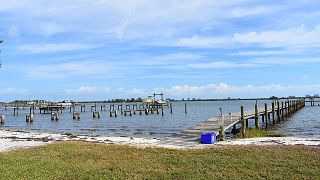Indian River: Difference between revisions
mNo edit summary |
|||
| (78 intermediate revisions by the same user not shown) | |||
| Line 1: | Line 1: | ||
< | <div class="irlbody irlbow"> | ||
{{ | {{IRL header estuary|cat=Indian River}} | ||
<div class="irlcontenttop"> | |||
[[File:Indian River Saint Lucie Village.jpg|320px|thumb|right|alt=View of the Indian River at Saint Lucie Village|Indian River at St. Lucie Village]] | |||
'''Indian River''' (''Rio de Ais'') is a 121 mile long brackish water lagoon spanning five counties on Florida's East Coast. Indian River is the largest of the three lagoonal basins in the Indian River Lagoon National Estuary watershed. | |||
The Indian River's brackish water is a confluence of four Atlantic Ocean saltwater inlets ([[Sebastian Inlet|Sebastian]], Ft. Pierce, St. Lucie and Jupiter), four freshwater rivers (Eau Gallie, Sebastian, Saint Lucie, and Loxahatchee), and numerous feeder creeks. | |||
</div> | |||
<div class="irlcontentmiddle"> | |||
==Location== | |||
Indian River lagoon's northern boundary is [[:Category:Brevard County|Brevard County's]] Scottsmoor at Turnbull Creek. The lagoon merges with the [[Banana River]] lagoon at the southern tip of Merritt Island, and then ranges southward to [[:Category:Palm Beach County|Palm Beach County's]] Loxahatchee River and Jupiter Inlet. | |||
== | |||
== | Coordinates: 28°04'46.1"N, 80°35'16.9"W | ||
<div | GIS:28.079483,-80.588031 | ||
<div | {{Map Embed|coord=28.079483,-80.588031|zoom=10}} | ||
<!--<div class="irlmap">{{#cargo_display_map:point=28.079483, -80.588031|service=googlemaps|width=420px|height=640px|zoom=8 |}}</div>--> | |||
</div> | </div> | ||
<div class=" | <div class="irlcontentmiddle"> | ||
==Water Body== | |||
<div class=" | <div class="mw-collapsible mw-collapsed" style="width:330px; overflow:auto;"> | ||
<div class="irlcollapsetitle">Indian River Tributaries</div> | |||
<div class="mw-collapsible-content"> | <div class="mw-collapsible-content"> | ||
<div class="irlcollapsetext">Tributaries are listed from North to South.</div> | |||
<div>{{#section:Water Body List|indianriverwater}}</div> | |||
</div></div> | </div></div> | ||
<div class=" | </div> | ||
== | <div class="irlcontentmiddle"> | ||
<div class="mw-collapsible- | ==Bridge List== | ||
<div class="mw-collapsible mw-collapsed" style="width:330px; overflow:auto;"> | |||
<div class="irlcollapsetitle">Indian River Bridges</div> | |||
< | |||
<div class="mw-collapsible-content"> | <div class="mw-collapsible-content"> | ||
<div class="irlcollapsetext">Bridges and Causeways are listed from North to South.</div> | |||
<div>{{#section:Bridge List|indianriverbridgelist}}</div> | |||
<div class=" | |||
< | |||
</div></div> | </div></div> | ||
</div> | </div> | ||
<div class="irlcontentmiddle"> | |||
==Odor== | |||
Indian River's earthen berm causeways tend to impede the flow of algae and rotting [[seagrass]] which results in an odor of hydrogen sulfide (ie: rotten eggs) during Florida's hot summer months. | |||
In this video, Dr. Duane DeFreese of the IRC Council explains why the Indian River occasionally smells bad. | |||
{{#evl:E5mSF51odyw|Why does the Indian River Smell?|1|player=youtube}} | |||
<evlplayer w="320" id="youtube"><div style="width:320px;">https://img.youtube.com/vi/E5mSF51odyw/0.jpg</div></evlplayer> | |||
< | |||
<div style="width: | |||
</div></ | |||
</div> | </div> | ||
<div class="irlcontentbottom"> | |||
== | ==Web Links== | ||
* [http://fcit.usf.edu/florida/docs/i/indriv2.htm An early 20th Century description of the Indian River] | |||
* [http://www.nbbd.com/godo/ef/hernandez/index.html Hernandez Trail History] | |||
<!-- | <!-- | ||
==References== | |||
<references /> | |||
--> | |||
= | </div> | ||
{{IRL footer estuary|cat=Indian River}} | |||
</div> | |||
[[Category:Indian River]] | [[Category:Indian River]] | ||
[[Category:Indian River | [[Category:Indian River Water Body]] | ||
Latest revision as of 14:20, December 26, 2021
Indian River (Rio de Ais) is a 121 mile long brackish water lagoon spanning five counties on Florida's East Coast. Indian River is the largest of the three lagoonal basins in the Indian River Lagoon National Estuary watershed.
The Indian River's brackish water is a confluence of four Atlantic Ocean saltwater inlets (Sebastian, Ft. Pierce, St. Lucie and Jupiter), four freshwater rivers (Eau Gallie, Sebastian, Saint Lucie, and Loxahatchee), and numerous feeder creeks.
Location
Indian River lagoon's northern boundary is Brevard County's Scottsmoor at Turnbull Creek. The lagoon merges with the Banana River lagoon at the southern tip of Merritt Island, and then ranges southward to Palm Beach County's Loxahatchee River and Jupiter Inlet.
Coordinates: 28°04'46.1"N, 80°35'16.9"W GIS:28.079483,-80.588031
Water Body
Brevard County
- Turnbull Creek
- Haulover Canal
- Gator Creek
- Catfish Creek
- Banana Creek
- Canaveral Barge Canal
- Horse Creek
- Banana River
- Eau Gallie River
- Crane Creek
- Turkey Creek
- Goat Creek
- Kid Creek
- Trout Creek
- Mullet Creek
Indian River County
- Saint Sebastian River
- Sebastian Inlet
St. Lucie County
- Taylor Creek
- Fort Pierce Inlet
- Moores Creek
Martin County
- Saint Lucie River
- Saint Lucie Inlet
Palm Beach County
- Loxahatchee River
- Jupiter Inlet
Bridge List
Brevard County
- NASA Railroad Bridge
- A. Max Brewer Memorial Parkway SR406 (info)
- NASA Parkway Causeway SR405 (info)
- Beachline Causeway SR528
- Hubert Humphrey Bridge SR520
- Pineda Causeway SR404 (info)
- Eau Gallie Causeway SR518 (info)
- Melbourne Causeway US192
- Sebastian Inlet Bridge A1A (info)
Indian River County
- Wabasso Causeway SR510 (info)
- Merrill P. Barber Bridge (info)
- Alma Lee Loy Bridge SR656 (info)
St. Lucie County
- North Causeway USA1A
- Seaway Drive Causeway USA1A
Martin County
- Frank Wacha Bridge CR732
- Ocean Blvd Causeway
- Ernest Lyons Bridge A1A (info)
- Evans Crary Bridge A1A - St.Lucie River
- Roosevelt Bridge US1 - St. Lucie River (info)
- SE Bridge Rd. Causeway CR707
Palm Beach County
- South Beach Road Causeway CR707
Odor
Indian River's earthen berm causeways tend to impede the flow of algae and rotting seagrass which results in an odor of hydrogen sulfide (ie: rotten eggs) during Florida's hot summer months.
In this video, Dr. Duane DeFreese of the IRC Council explains why the Indian River occasionally smells bad.


